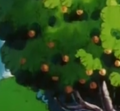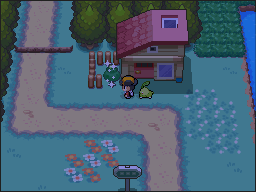Apricorns (Japanese: ぼんぐりのみ Bonguri Fruit) are special fruits that are native to the Johto region. They appear to be related to Berries, and are encountered only in Pokémon Gold, Silver, Crystal, HeartGold, and SoulSilver.
The most major difference between Apricorns and Berries is in the use of the fruit. While Berries can be used in and outside battle by a Pokémon, an Apricorn's outer skin is far too tough for it to be eaten by a Pokémon. Instead, they must first be blended into juice. Usually, Apricorns are hollowed out by specialists and fitted with special devices to be used to catch Pokémon. One such specialist, Kurt, lives in Azalea Town with his granddaughter, Maizie, who assists him in his work.
The special Poké Balls made from Apricorns are unique, quite rare, and often valuable for a Trainer to have on hand in battle. This is due to the fragile nature of Apricorn trees, which may die if too many Apricorns are picked at once or before they are mature enough. Only one Apricorn may be picked per tree per day, in order to prevent harm to it.
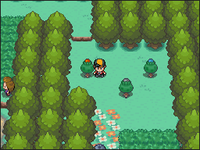
The group of Apricorn trees on
Route 37 in Generation IV
In times gone by, the only Poké Balls that existed were made from Apricorns, with the process used to create the Poké Balls being developed sometime between 400 and 700 years before the present day in all Pokémon canons. As they were the only Poké Balls at the time, Apricorn Balls were quite common, unlike in modern times, when large companies such as Silph Co. and the Devon Corporation develop Poké Balls mechanically and mass-produce them for use by Trainers.
List of Apricorns
|
|
|
| Cannot be bought
|
| Sell for: $100*
|
|
|
|
|
| Secondary effect:
|
If used in the Apriblender, can produce Aprijuice that boosts the Power and Stamina Performance stats.
|
|
| Description
|
| GSC
|
A black Apricorn.
|
| HGSS
|
A black Apricorn. It has an indescribable scent.
|
| BWB2W2
|
A black Apricorn. It has an indescribable scent.
|
| XYORAS
|
A black Apricorn. It has a scent beyond one's experience.
|
| SM
|
A black Apricorn. It has a scent beyond one's experience.
|
| USUM
|
A black Apricorn. It has a scent beyond one's experience.
|
|
| Note: Formatted as Blk Apricorn prior to Generation VI
|
|
|
|
|
| Cannot be bought
|
| Sell for: $100*
|
|
|
|
|
| Secondary effect:
|
If used in the Apriblender, can produce Aprijuice that boosts the Skill Performance stat.
|
|
| Description
|
| GSC
|
A blue Apricorn.
|
| HGSS
|
A blue Apricorn. It smells a bit like grass.
|
| BWB2W2
|
A blue Apricorn. It smells a bit like grass.
|
| XYORAS
|
A blue Apricorn. It smells a bit like grass.
|
| SM
|
A blue Apricorn. It smells a bit like grass.
|
| USUM
|
A blue Apricorn. It smells a bit like grass.
|
|
| Note: Formatted as Blu Apricorn prior to Generation VI
|
|
|
|
|
| Cannot be bought
|
| Sell for: $100*
|
|
|
|
|
| Secondary effect:
|
If used in the Apriblender, can produce Aprijuice that boosts the Jump Performance stat.
|
|
| Description
|
| GSC
|
A green Apricorn.
|
| HGSS
|
A green Apricorn. It has a mysterious, aromatic scent.
|
| BWB2W2
|
A green Apricorn. It has a mysterious, aromatic scent.
|
| XYORAS
|
A green Apricorn. It has a mysterious, aromatic scent.
|
| SM
|
A green Apricorn. It has a mysterious, aromatic scent.
|
| USUM
|
A green Apricorn. It has a mysterious, aromatic scent.
|
|
| Note: Formatted as Grn Apricorn prior to Generation VI
|
|
|
|
|
| Cannot be bought
|
| Sell for: $100*
|
|
|
|
|
| Secondary effect:
|
If used in the Apriblender, can produce Aprijuice that boosts the Speed Performance stat.
|
|
| Description
|
| GSC
|
A pink Apricorn.
|
| HGSS
|
A pink Apricorn. It has a nice, sweet scent.
|
| BWB2W2
|
A pink Apricorn. It has a nice, sweet scent.
|
| XYORAS
|
A pink Apricorn. It has a nice, sweet scent.
|
| SM
|
A pink Apricorn. It has a nice, sweet scent.
|
| USUM
|
A pink Apricorn. It has a nice, sweet scent.
|
|
| Note: Formatted as Pnk Apricorn prior to Generation VI
|
|
|
|
|
| Cannot be bought
|
| Sell for: $100*
|
|
|
|
|
| Secondary effect:
|
If used in the Apriblender, can produce Aprijuice that boosts the Power Performance stat.
|
|
| Description
|
| GSC
|
A red Apricorn.
|
| HGSS
|
A red Apricorn. It assails your nostrils.
|
| BWB2W2
|
A red Apricorn. It assails your nostrils.
|
| XYORAS
|
A red Apricorn. It assails your nostrils.
|
| SM
|
A red Apricorn. It assails your nostrils.
|
| USUM
|
A red Apricorn. It assails your nostrils.
|
|
|
|
|
| Cannot be bought
|
| Sell for: $100*
|
|
|
|
|
| Secondary effect:
|
If used in the Apriblender, it produces a flavorless Aprijuice that has no effect.
|
|
| Description
|
| GSC
|
A white Apricorn.
|
| HGSS
|
A white Apricorn. It doesn't smell like anything.
|
| BWB2W2
|
A white Apricorn. It doesn't smell like anything.
|
| XYORAS
|
A white Apricorn. It doesn't smell like anything.
|
| SM
|
A white Apricorn. It doesn't smell like anything.
|
| USUM
|
A white Apricorn. It doesn't smell like anything.
|
|
| Note: Formatted as Wht Apricorn prior to Generation VI
|
|
|
|
|
| Cannot be bought
|
| Sell for: $100*
|
|
|
|
|
| Secondary effect:
|
If used in the Apriblender, can produce Aprijuice that boosts the Stamina Performance stat.
|
|
| Description
|
| GSC
|
A yellow Apricorn.
|
| HGSS
|
A yellow Apricorn. It has an invigorating scent.
|
| BWB2W2
|
A yellow Apricorn. It has an invigorating scent.
|
| XYORAS
|
A yellow Apricorn. It has an invigorating scent.
|
| SM
|
A yellow Apricorn. It has an invigorating scent.
|
| USUM
|
A yellow Apricorn. It has an invigorating scent.
|
|
| Note: Formatted as Ylw Apricorn prior to Generation VI
|
|
Differences between generations
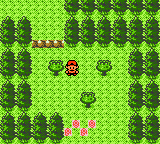
The group of Apricorn trees on
Route 37 in Generation II
While Apricorns have retained their properties between the five games in which they are available, the most major tweak to them has been their availability. In all Generation II games, only one of each is available per day, from the Apricorn trees on Routes 37 and 42 and in Azalea Town. In Crystal Version, Kurt is able to make more than one Apricorn Ball per day, if he is given multiple Apricorns of the same color.
The return of Apricorns in HeartGold and SoulSilver Versions solves much of the problem of their availability, with all trees containing the Generation II Berries now having Apricorns growing instead, with some now doubled up, with two trees, rather than one, in some areas. The problem of holding them when they are found is also remedied, as they no longer are placed in the Bag's items pocket, but instead in the Apricorn Box, a Key Item that acts much in the same way that the Berry Pouch did in Pokémon FireRed and LeafGreen.
While Apricorns and the Poké Balls that are made from them can be held by a Pokémon in Generation II, this is not allowed in the Generation IV remakes, as these items are not programmed into the other games of that generation. However, a Pokémon caught in an Apricorn Ball can be traded into Diamond, Pearl or Platinum, but the Ball will appear as a plain Poké Ball for as long as that Pokémon remains in the Sinnoh-based game.
Apricorns can further be used in Generation IV, a side effect of their increased availability. In this generation, the seven can be mixed together into special drinks for Pokémon with an Apriblender, which improve a Pokémon's performance in the various Pokéathlon competitions. Much like Berries, the color of the Apricorns roughly matches up to their flavor and to the Performance stat that they enhance.
In the anime
Apricorns made their only anime appearance in Going Apricorn!. After Kurt had given Ash, Misty, and Brock a Fast Ball each, made from White Apricorns growing next to his house, he sent them to collect other Apricorns with Maizie. After several failed attempts at picking up Apricorns, the group managed to pick up two Blue Apricorns and a Black Apricorn, which Kurt used to make a pair of Lure Balls and a Heavy Ball for them, which they obtained shortly before leaving Azalea Town in the next episode.
Gallery
In the manga
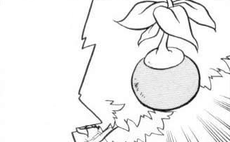
An Apricorn in Pokémon Adventures
In the Pokémon Adventures manga
Apricorns were first seen in Teddiursa's Picnic, where Kurt's ability to turn them into special Poké Balls was demonstrated. Gold, unaware of Apricorns' true purpose, attempted and failed to eat one from a tree.
In Yikes, It's Yanma!, an Apricorn lottery was used to randomly decide which pairs of Gym Leaders from Kanto and Johto would face each other in an interregional exhibition match at Indigo Plateau. Erika and Pryce, due to their statuses as the leaders of their respective region's Gym Leaders, were automatically selected to battle each other.
In Out-Odding Oddish, Gold was seen running around the Pokéathlon Dome to make Aprijuice out of Apricorns with his Apriblender.
Trivia
- The word Apricorn may be a combination of "apricot" and "acorn". "Bonguri" may come from the Japanese chestnut, known as にほんぐり (nihonguri), or from the acorn, どんぐり (donguri).
- A woman in the Azalea Town Pokémon Center mentions that before Poké Balls became standardized, everyone used hollowed-out Apricorns to capture Pokémon.
- Apricorns have sprites for the Apricorn Case as well as in-Bag sprites, which are only used in the point-exchange menu in the Pokéathlon Dome.
- In Generation IV, Green Apricorns are by far the most common, appearing in eight places. White and Red Apricorns are tied for the rarest, each only appearing in three places.
- In Generation II, all Apricorns can only be found in one place.
- In the anime, possibly as a coloring error, Black Apricorns were portrayed as being brown-colored.
- Because of the length of the word "Apricorn", only the Red Apricorn is able to have its full color name in English prior to Generation VI, with the other six having abbreviated versions because item names are limited to 12 characters (including spaces). Starting in Generation VI, item names can be longer, and the Apricorns are all spelled out in full in English, despite being unobtainable. In all generations in Japanese, abbreviation is used only for the Green Apricorn, which uses みど mido as an abbreviated form of みどり midori, green.
- In Generation IV, if an Apricorn tree is left bare and on-screen without turning the game off over midnight, the plant will sparkle (in the same way Berry plants do when advancing a stage) and an Apricorn will appear on it. If the game was in sleep mode (the Nintendo DS was closed) over midnight, this will happen as soon as the game is taken out of sleep mode.
In other languages











